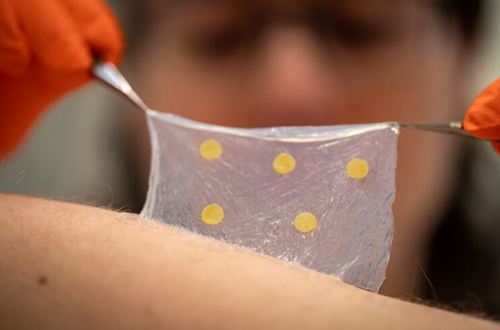
Researchers at Linköping University in Sweden created a wound dressing that can provide a visual indication if the underlying wound is infected. Chronic wounds are difficult to manage, and presently healthcare staff must remove the dressing regularly to check if an infection is developing. However, this can disrupt the wound by damaging the scab, impairing healing, and may even introduce pathogens in the process. This latest technology takes advantage of the tendency of infected wounds to show a reduction in acidity and become more basic. It consists of a nitrocellulose dressing that contains mesoporous silica nanoparticles that are loaded with a dye that changes color at higher pH levels, providing a clear indicator of infection without the need to remove the bandage regularly.
Chronic wounds are a huge burden for healthcare staff and patients alike. The risk of infection is ever present, and with multidrug-resistant bacteria on the rise, treating such infections is not always straightforward. Another issue lies with the need to check on the wound regularly to see if infection has occurred. This involves healthcare staff removing the wound dressing every couple of days and checking for signs of infection, such as redness, increased pain, or the presence of pus.
However, removing a wound dressing can have unforeseen consequences. It is possible that the scab layer can be disrupted when the dressing is peeled back, impairing the healing process. Moreover, the dressing provides a barrier to protect the wound, and removing it regularly could allow bacteria to access the area and start an infection.
To address these issues, these researchers have developed a wound dressing that is designed not to be removed regularly, but which will still allow healthcare workers, or even patients themselves to know if the wound is infected. “Being able to see instantly whether a wound has become infected, without having to lift the dressing, opens up for a new type of wound care that can lead to more efficient care and improve life for patients with hard-to-heal wounds,” said Daniel Aili, a researcher involved in the study. “It can also reduce unnecessary use of antibiotics.”

The new dressing is based on the premise that non-infected wounds tend to have a pH of 5.5, whereas infected wounds are more basic with a pH as high as 8 or over. The dressing contains mesoporous silica nanoparticles that have been loaded with a dye called bromthymol blue, which will change color from yellow to blue when the pH rises above 7.
Happily, the dressing will change color at the very early stages of an infection, often before the presence of other visible signs such as redness or pus, allowing healthcare staff to address the problem as quickly as possible.
Study in journal Materials Today Bio: Nanocellulose composite wound dressings for real-time pH wound monitoring
Via: Linköping University
Source: medgadget.com




